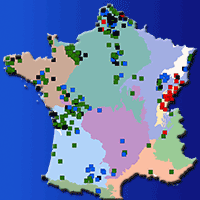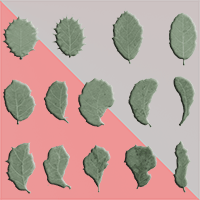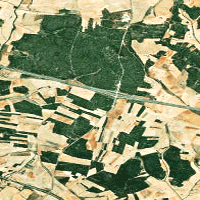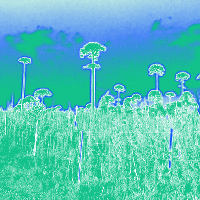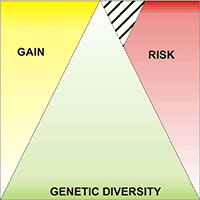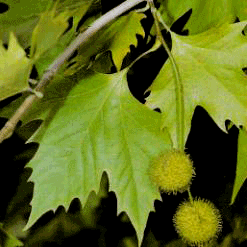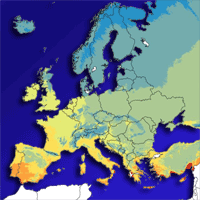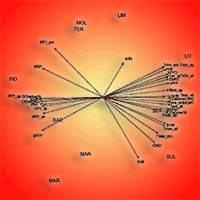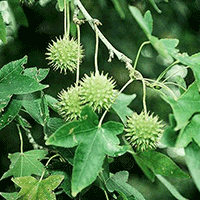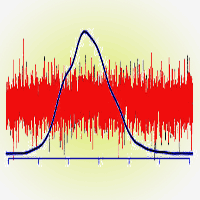
A comparative fluctuating asymmetry study between two walnut (Juglans regia L.) populations may contribute as an early signal for bio-monitoring
YAI Kourmpetis (1), FA Aravanopoulos (2)
iForest - Biogeosciences and Forestry, Volume 3, Issue 6, Pages 150-152 (2010)
doi: https://doi.org/10.3832/ifor0552-003
Published: Nov 15, 2010 - Copyright © 2010 SISEF
Research Articles
Abstract
Developmental stability, the ability of an individual to eliminate environmental disturbances while expressing a heritable phenotypic trait, was compared in two walnut (Juglans regia L.) populations, a natural and an artificial. Bilateral leaf morphometrics were used to estimate fluctuating asymmetry which refers to random deviation from perfect symmetry of bilateral traits resulting from extrinsic and intrinsic perturbations not buffered during development. Fluctuating asymmetry was used as a proxy of developmental stability. We analyzed our data from a Bayesian perspective showing that developmental stability levels are decreased in the natural population. Our results indicate that an attention may be directed towards the conservation of the natural walnut resources of the area. Fluctuating asymmetry as an indicator of developmental stability may contribute especially in the framework of comparative studies as a population biomonitoring tool.
Keywords
Signal asymmetry, Directional asymmetry, Developmental stability, Bio-monitoring, Conservation
Authors’ Info
Authors’ address
Biometris, Wageningen University and Research Center, Wageningen (The Netherlands)
Laboratory of Forest Genetics and Tree Breeding, Faculty of Forestry and Natural Environment, Aristotle University of Thessaloniki, Thessaloniki (Greece).
Corresponding author
Paper Info
Citation
Kourmpetis YAI, Aravanopoulos FA (2010). A comparative fluctuating asymmetry study between two walnut (Juglans regia L.) populations may contribute as an early signal for bio-monitoring. iForest 3: 150-152. - doi: 10.3832/ifor0552-003
Paper history
Received: Jul 10, 2010
Accepted: Sep 22, 2010
First online: Nov 15, 2010
Publication Date: Nov 15, 2010
Publication Time: 1.80 months
Copyright Information
© SISEF - The Italian Society of Silviculture and Forest Ecology 2010
Open Access
This article is distributed under the terms of the Creative Commons Attribution-Non Commercial 4.0 International (https://creativecommons.org/licenses/by-nc/4.0/), which permits unrestricted use, distribution, and reproduction in any medium, provided you give appropriate credit to the original author(s) and the source, provide a link to the Creative Commons license, and indicate if changes were made.
Web Metrics
Breakdown by View Type
Article Usage
Total Article Views: 56200
(from publication date up to now)
Breakdown by View Type
HTML Page Views: 48154
Abstract Page Views: 3109
PDF Downloads: 3551
Citation/Reference Downloads: 10
XML Downloads: 1376
Web Metrics
Days since publication: 5514
Overall contacts: 56200
Avg. contacts per week: 71.35
Citation Metrics
Article Citations
Article citations are based on data periodically collected from the Clarivate Web of Science web site
(last update: Mar 2025)
Total number of cites (since 2010): 3
Average cites per year: 0.19
Publication Metrics
by Dimensions ©
Articles citing this article
List of the papers citing this article based on CrossRef Cited-by.
References
Allozyme analysis of genetic diversity and differentiation in European and Asiatic walnut (Juglans regia L.) populations. Forest Genetics 6: 115-127.
Gscholar
Fluctuating asymmetry analyses: a primer. In: “Developmental instability: its origins and evolutionary implications” (Markow T ed). Kluwer Academic Publishers, Dordrecht, Germany, pp. 335-364.
Gscholar
Fluctuating asymmetry analyses revisited. In “Developmental instability (DI): causes and consequences” (Polak M ed). Oxford University Press, Oxford, UK, pp. 279- 319.
Gscholar
JAGS: A program for analysis of Bayesian graphical models using Gibbs sampling. In: Proceedings 3rd International Workshop on “Distributed Statistical Computing”.
Gscholar
CODA: Convergence diagnosis and output analysis for MCMC. R News 6: 7-11.
Gscholar
The heritability of fluctuating asymmetry: a Bayesian hierarchical model. Annales Zoologici Fennici 37: 15-24.
Gscholar

